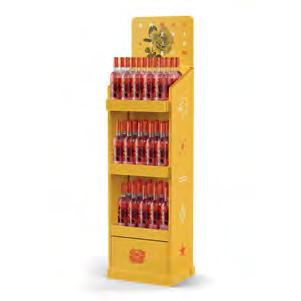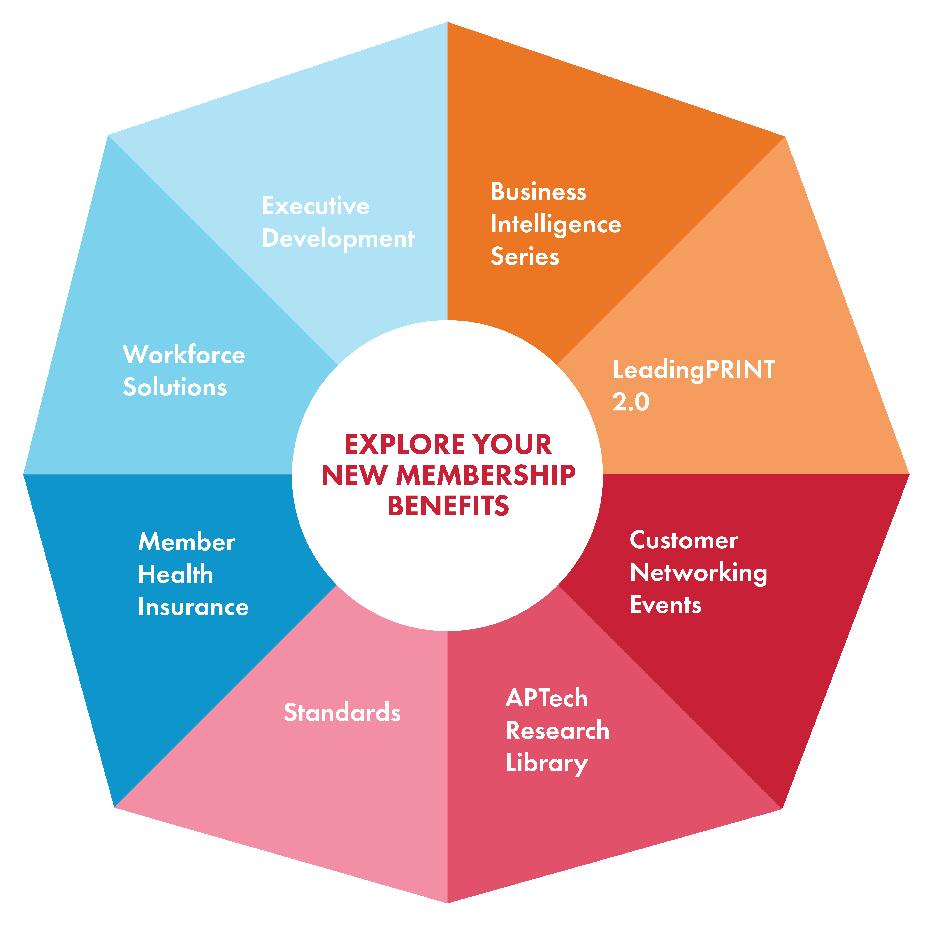
Why B2B buyers think they’re smarter than you
What printers look like in 2020 and beyond
The art of managing people today
Print CEOs on changing your mindset


Why B2B buyers think they’re smarter than you
What printers look like in 2020 and beyond
The art of managing people today
Print CEOs on changing your mindset
Vision and friendliness set
Vision and friendliness set
Bennett Graphics apart
Bennett Graphics apart
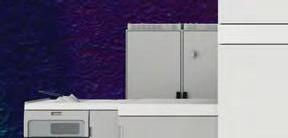




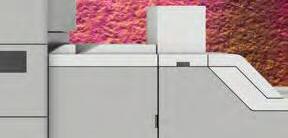



A testament to customer-driven inkjet innovation, the latest iteration of the VarioPrint i-series uses an expanded color gamut, increased throughput, and more than 50 coated and gloss media options to give you the ability to accurately print larger volumes at higher speeds.




Thayer Long President, Association for PRINT Technologies
For progressive
printing company owners,
it is high time to understand the impact of this extraordinary evolution.
Business model innovation is hardly new. Heck, Gutenberg was innovating by seeking out mechanical applications for the printing device he invented. But the scale and speed at which innovative business models are transforming industry landscapes like ours is unprecedented. For progressive printing company owners, it is high time to understand the impact of this extraordinary evolution. Now is the time to address the challenge of business model innovation.
Ultimately, a robust business model is about creating value for both internal and external stakeholders. In turn, innovation is about replacing outdated models. Consider, for example, inkjet technologies that are transforming our industry. While we think that it is exciting new technology, it is innovation in response to emerging customer needs and market dynamics.
In order to invent, design and implement powerful new models, it may simply start by removing the idea of sustaining your business as a goal of the organization. Aiming to survive the cyclicality of business and maintain revenue over time lacks a bit of inspiration. The rinse and repeat approach used by companies like Blockbuster rapidly grows stale.
While viable businesses endeavor to protect what they have, resilient businesses reinvent. Netflix-like companies insulate themselves by being unafraid to reinvent their models
over and over. So, while a sustainable business’ primary objective is revenue, the resilient company focuses on value creation.
The time has come for us all to replace the idea of sustainability with resiliency. Progressive printers across the country have come to embrace the idea of creating value for their clients rather than just producing print. And similarly, APTech has begun to redefine itself through resiliency rather than sustainability. We are not interested in simply surviving the changing landscape—we want to thrive in it.
We hope you will join us as we embark on some exciting new ventures. LeadingPRINT, as an example, has emerged as a wonderful community builder and will now include faceto-face summits. Our new higher education strategy includes EDgage magazine (www.edgagemag.com) along with regional events with higher ed marketers. And our new market segment platform will be unveiled early in 2020. All in all, APTech has chosen to be resilient by creating new platforms of engagement for you and your target markets.
Enjoy the issue and here’s to a thriving new year.

2 4 8 12 14 16 20 24
REGISTRATION MARKS
Facts, figures, and data that matters
SOUTHERN HOSPITALITY
Vision and friendliness set Bennett Graphics apart
THE NEW B2B BUYER
Why they think they are smarter than you
THE ROARING TWENTIES
What printers look like in 2020 & beyond
INDUSTRY INSIGHTS
Economic outlooks and news
BOSS TALK
Print CEOs weigh in on why changing your mindset matters, and more
ORCHESTRATING HUMANS
Managing people today
THE EVOLUTION OF U.S. RETAIL PRINT
Publisher Editor Design
Julie Shaffer Michael Pallerino Conduit, Inc.
LeadingPRINT magazine is published four times per year by the Association for PRINT Technologies.
Find us online PRINTtechnologies.org twitter.com/APT_tech | facebook.com/APTtechorg linkedin.com/company/association-for-print-technologies
For advertising opportunities, contact Sondra Benoudiz at sbenoudiz@aptech.org.
Send feedback and story ideas to jshaffer@aptech.org
Please recycle this magazine.
All rights reserved © 2020. Association for PRINT Technologies.
LeadingPRINT magazine is a benefit of belonging to the Association for PRINT Technologies. To learn how to become a member, contact Pernilla Jonsson at pjonsson@aptech.org.

“Great leaders motivate and inspire people with why they’re doing it. That’s purpose. And that’s the key to achieving something truly transformational.”
Marillyn Hewson, Chairwoman, President and CEO of Lockheed Martin, on being a leader
Finding and keeping good employees continues to be an issue for businesses. It’s estimated in a recent Gallup report that voluntary turnover costs U.S. businesses about one trillion dollars each year. So how do you keep your employees happy? Let’s take a look at Shiftboard’s “2019 State of the Hourly Worker Report” to see the most important factors of job satisfaction:
77%
Work-life balance
64%
Good working relationship with your boss
66% Being paid well
62% Working in a convenient location
58% Enjoying the tasks or activities done at work
How leaders engage with others is an integral part of their leadership strategy. They should encourage and inspire their team, as well as foster an environment for growth. Here are some leadership tips from Center for Creative Leadership’s “Executive Integration Equipping Transitioning Leaders for Success:”
1 2 3
If workers don’t know what they’re working towards, they won’t have a reason to work other than a paycheck. They should have personal goals, as well as understand the company’s goals. Increase their engagement by showing them their impact on the company and keeping them up to date on the company’s successes.
Communication is crucial in any working relationship. Workers want to know what they are doing right and where they can improve. If you are only telling them what they are good at, they will never know how to do better. Likewise, if you are only pointing out their mistakes, they will become frustrated. Finding the balance is key.
Everyone is afraid to fail and have the blame land on them. For a company to grow, risks need to be taken. If employees think they will be fired for the slightest error, they will never take initiative to innovate. Allow room for mistakes, and see what creative potential could be unleashed.
Vision and friendliness set Bennett Graphics apart
By David Bennett
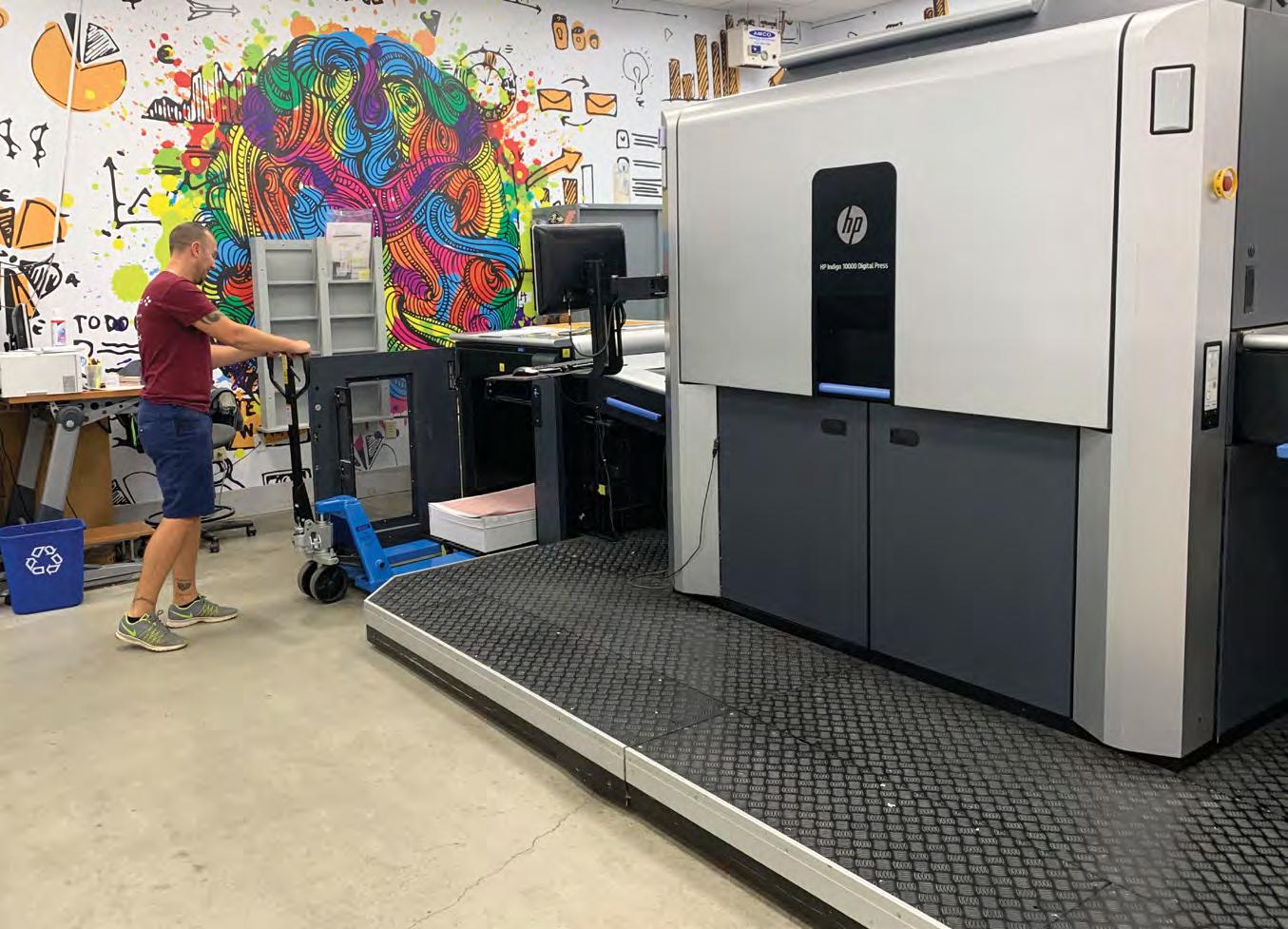
About six years ago, I sat down with my executive team—Mark Adent, VP, Scott Carroll, VP of Operations, and Bill Gillespie, VP of Sales—to scope out how we could grow and diversify our company. We prepared a spreadsheet that profiled each business segment, and then drilled down into what areas might be advantageous to attack. The meeting was not based on something a competitor did or what was happening in the industry at the time. The meeting was about what Bennett Graphics will look like in six months. One year. Two years down the road.
By David Bennett
The concept is pretty simple. We are not a company that is satisfied with operating in the status quo. Companies that succeed—the leaders—create big change. They don’t follow it. In other words, complacency is an easy trap to get caught in, so our mindset is to always stay ahead of the curve and we want to execute with a culture of hospitality.

We spend zero amount of our time thinking about the competition. As a group, we believe that worrying about somebody else’s next move or what equipment they have is a waste of time.
I always tell my team to look for ways to say, “Yes, we can do that.” If you do not, someone else will.
We focus on the validity of ideas, the power of our solutions and the impact that a friendly and generous culture has on the marketplace. In turn, we believe leadership indicates that you are confident that the solutions you offer are the best in the market. Bill and the sales team have bought into this mindset and that allows us to stand out from the rest. All in all, we encourage our employees to let everyone know that this is the best place to work and that hospitality matters.
The humble swagger is part of our image.
For us, no matter what history says about our growth—and we have been blessed to have done well—the work is not promised; it is earned. As printers, we are tasked to build a business in an industry where there are no guaranteed orders tomorrow. Or the next day. So we keep looking into the future.
Following that pivotal meeting, our brain trust decided to make wide format our next new venture. We attended a show focused on this space so that we could see possibilities, applications and devices. Few were doing this at the time.
Over the course of the past few years, we have met regularly. We discussed industry trends, product innovations, best practices and an industry racked with aging employees. One of the edicts we made was to get more involved on the Clemson University campus, where we could focus on sales and client service recruiting. Clemson’s Intern/Employer Day event became our new best friend, leading us to be on campus at least twice a year. Bill even started teaching printing sales classes, which extends our impact and allows us to connect with the next generation.
In three years, we added five graduates to our team—two salespeople, two client service reps and one estimator. After a few years into the job, one of those sales reps is expected to generate more than $1 million in sales this year. What makes us really proud is that Clemson talks about Bennett Graphics as if we are an extension of their program. It is just another example of leading through a hospitable culture.

Over the past 50 years, Bennett Graphics has built a brand that thrives in a marketplace subjected to margin pressures and overcapacity. We have constructed a dynamic team that is dedicated to always looking for exciting and innovative ways to build our portfolio. We have a collective mindset that there is always something new to learn in an industry that is constantly changing. We are not afraid to take risks.
That mindset matters most when a client comes to us with a vague idea of what they want, but might need a little direction in polishing it up. Our clients know they can ask us anything. They know we listen, learn and deliver.
I think that the secret to success—the Holy Grail that we all chase—comes down to culture. When you have the right culture, you make it easier for good people to want to be a part of what you are doing—and stick around for the ride.
A hospitable culture is infectious, not just for your staff, but your clients, too. Bennett Graphics’ clients know that we will do what it takes to deliver what they want. We invite them to test ideas and are set on showing them all the possibilities that exist on any given project. When your clients, sales rep and production team are all on the same side, it makes everything better.
One of our clients told us recently that Bennett Graphics is a special place.
“I’m not talking about your equipment; I’m talking about your people. I’ve seen printing equipment before. All of my vendors have them. It’s your excitement, your vision, the way you involve people in your success and make it theirs.”


I have quoted this person, who represents a nationally recognized brand, scores of times since the day she shared her thoughts with us. You cannot write better marketing copy than her testimonial. Her words are something that every one of our employees takes to heart.
On the marketing side, we strive to show really cool applications in everything we do. Our focus is always on the creative process. We are creative enablers. We say yes, except for when we have to say, “I don’t know. Let’s try it.” When we create content, whether for a printed piece or a social media initiative, we focus on what clients want, not whether it has to be printed. We rarely talk about specific devices. We talk about what we can do today—functions, outcomes, etc. There is nothing better than seeing a client switch from how much something costs to what possibilities exist.
As I look at where Bennett Graphics stands today and where we are heading, I thought it might be helpful to share some of the tenets our team uses to drive business in print’s new age.
Giving your customers what they want means you must be willing to do what it takes. Too many printers rely on price to sell jobs. Companies that think along those lines miss the real sales triggers and end up hurting their own business. While a customer might want the best price, in the end, success is when you become fluent in their world, and use your tools and expertise to better solve

their problems. At Bennett Graphics, we have a seven-step system that helps us become more fluent in our customers’ business:
Identify
Develop solutions
Share your plan
Evaluate and adjust
Test
Plan actions and execute
Get the process down
The combination of a systemic process of understanding and our hospitable culture works beautifully. I recall a salt ingredient client who needed a box that would contain crackers and chips, and could be sent to 19 different countries. In addition to protecting the salty snacks, the kit was to be personalized. Learning how to get food into 19 countries, each with different guidelines and protocols, felt like salt in the wound. But we researched, scripted solutions, evaluated ideas and tested appropriately. We realized that each kit required its own plan, including paperwork, loading protocols, and different languages. And the plan worked, with 19 kits selling for more than $40,000. The fact that we got the kits to the right person without any hang-ups was the sales trigger, not price.
The machines are the hammer and nails.
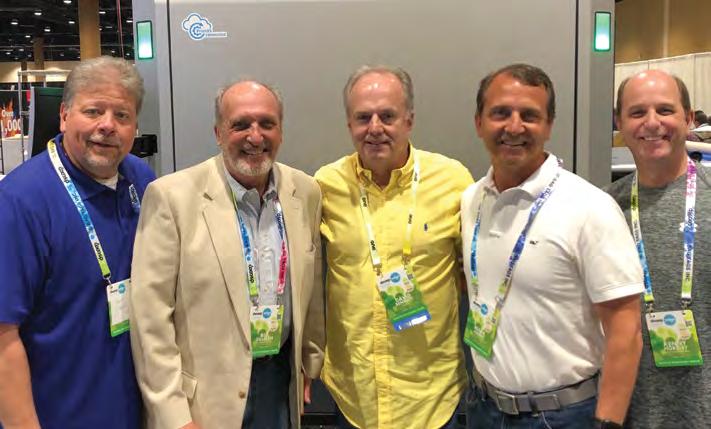
Listen. Respond. Produce. Repeat. When you incubate a culture of generosity, other characteristics—openness, honesty and consistency—begin to emerge. Don’t get me wrong, we are not perfect, and nobody expects us to be. But if you want your customers and employees to follow your lead, those qualities count. Building a brand people want to be a part of means you have to be honest and consistent in your practice. I always tell my team to look for ways to say, “Yes, we can do that.” If you do not, someone else will. It does not have to be a new solution every time, but you want to put some distance between you and the competition. Focus on the “why” over the “what,” and see the value of every communication from the client’s perspective.
Find your lane
We are comfortable being a print company. I continue to hear the conversation about Marketing Service Provider (MSP) versus Print Service Provider (PSP). I think that discussion distracts from who we truly are. Print is already a marketing service, so we have chosen to define our company by the people we serve. We are a solutions provider that can deliver many things, to many people, in many situations. And thanks to a team that is truly hospitable, we have become synonymous with excellence, averaging three awards every 10 days for more than 15 years in everything from offset, digital, wide format, packaging, finishing and sustainability.
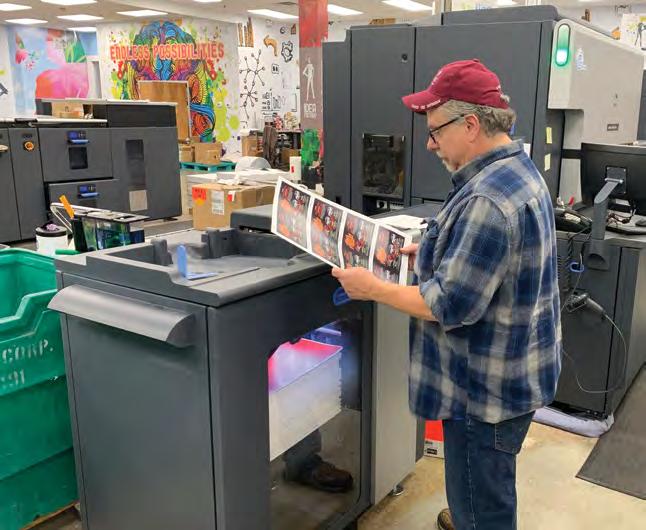
Bennett Graphics invests a tremendous amount of energy in understanding why clients print. Their outcomes are our outcomes. So, when you invite them to share their “why” before you turn your focus to the “what,” you win.
It is good to be respected for what you do. Bennett Graphics invests a tremendous amount of energy in understanding why clients print. Their outcomes are our outcomes. So, when you invite them to share their “why” before you turn your focus to the “what,” you win. This leads to service invention, solution design, technology investments, and the recruitment of elite talent. It is all a result of marrying vision with good ole’ fashioned southern hospitality.
As long as we continually remember that craftsmanship and client compassion are what matter most, we will be able to stand out. The machines are the hammer and nails. Our people are the magic. Every one of our employees is convinced that they are at the best place in the world. That’s hard to beat.
Our people are the magic.
David Bennett, a second generation printer, is the President of Bennett Graphics, a nationally recognized printing and marketing company in Tucker, Georgia. As leader of one of the industry’s most forward-thinking companies, he is recognized internationally for his vision and leadership with respect to communication technologies and business strategy. Connect via bennett@leadingprint.org
By Ray Glier










B2B IS NOT WHAT IT USED TO BE. A lot has changed, not in 20 years, not in 10 years, but in the last two or three years. The buyer has become an investigator of your offering with the help of the internet and social media. The buyer has pored over your marketing material and put you, the vendor, on the defensive.
And now the buyer has more sophisticated procurement software—Artificial Intelligence— dissecting you on price and performance.
Wesley J. Johnston, Ph.D., professor at Georgia State University and the director of the Center for Business and Industrial Marketing, says the B2B buying journey is 50-52% complete when human interaction occurs. Another study—Forrester’s “B2B Buyer Journey Map”— shows that as much as 74% of the buyer’s journey is done by the time things get down to brass tacks.
Then there is Sarah Scudder, president of Real Sourcing Network, who says the B2B journey is not 50% complete, or 74% complete, when the buyer gets down to making a deal. “That number, 74%, is underestimated.”
In fact, there is virtually no sales floor, Scudder says. Sales has been swallowed by marketing, and more marketing, and procurement software. “The world of buying and purchasing has completely changed and will continue to evolve. Organizations need to become marketing companies and provide relevant information as a way to sell, instead of the traditional sales role position where you have people cold-calling and emailing and contacting companies. The company buyers and decision-makers want to do their own research and reach out when they’re ready.”
So what does that leave for human interaction? Negotiation?
Not even that scrap, Scudder says. “The rise of artificial intelligence is completely changing the way that companies will even negotiate and kind of eliminate negotiation.”
RSN is a software company that provides an e-sourcing tool that automates a five-bid process on each print job. What that leaves, Scudder says, is buyers and suppliers working collaboratively on custom solutions that “solve needs, add value, and fall within budget.”
“The traditional printing company is not going to be around in 10 years,” Scudder says. “Companies that don’t innovate and provide unique solutions will be out of business. So, print companies need to figure out what their niche and expertise is, and what’s going to make them unique in the marketplace.”
For now, not every buyer is going to rely exclusively on artificial intelligence to cap deals.
One of the challenges to vendors presented by proactive buyers who do their own research is getting inside the buyer’s “friends and family circle.” Johnston says many companies are devoting energy to long-term customer relationship building to get inside the family. It has become increasingly important to find the trusted advisor inside because the buying cycle is so short for the vendor (longer for the buyer).
Marketing initiatives to set you up as a “problem solver” in the industry can be a way inside the “friends and family circle” where the better deals can be had, Johnston says.
“Print companies need to figure out what their niche and expertise is, and what’s going to make them unique in the marketplace.”
— Sarah Scudder, President, Real Sourcing Network
One other aspect of the new B2B buyer is that procurement is happening outside the C-level of the company, in many cases. While major decisions, like building an addition to the plant are carried out at the C-level, department heads and managers are making more of the day-today buys like print.





Johnston says vendors need to sharpen their skills at constructing buyer personas. LinkedIn and other social media tools can be a good resource for the print shop as it tries to hunt the decision-maker and influence them early in the game. “Scrape the internet, use those social media tools. Did the buyer give to the American Cancer Society? Use those things to build a profile of the approved buyer.”



The buyer is well-informed these days and thinks they can use that in negotiation. Johnston says it is important that vendors don’t let price be the bottom line. Get value in front of the buyer who thinks they know everything about the value of your product.
“The sales force may need to turn to something like the challenger approach—telling the customer about why his overall solution costs more,” Johnston says. “It offers more, connects deeply with the client's target community, saves money in the long run and, from a total cost of ownership perspective, may be cheaper.”
Maybe the competitor's price is the lowest, but in the long run it is not the best deal. A more robust approach would have the salesperson asking the customer questions about whether the competitor included this or that (storefronts, ad specialty items, signage,
training, etc.) in their proposal. If not, the value and depth of commitment would be much lower.
The buyer who has an armful of research can put a print shop on the defensive. Get off your heels, Johnston says.


The print salesperson can talk all day about why their solutions are better suited than the competition. In addition, they can reference the potential risks of purchasing a less expensive program with little response mechanisms and less connectivity. Johnston believes that for a few dollars you are risking a deeper problem. How will that affect your profits, job security, etc.?
Here is the issue: Companies have made it tough on themselves because they provide so much solid information about themselves. This is marketing, right? It is, but the salesperson now has a different job because of all that marketing. Their job is not to make the sales pitch; it is to confirm information the buyer has found, but also push back.
Get accustomed to it—the customer is much more active in the sales cycle these days. The good old days—two, three years ago— of cold-calling are gone.
For the print shop that is doing business matched up against sophisticated procurement software and research-able buyers, their marketing and sales teams better be finely coordinated. Indeed, these are no longer separate silos in a company; they are one.
Scudder says her growth and strategy is all run through a marketing eye. She has no sales team.
“The best coordinated marketing and sales efforts also use other kinds of databases such as social media, sales intelligence and competitor analysis.”
Wesley J. Johnston, Ph.D., Director, Georgia State University’s Center for Business and Industrial Marketing
The strategy is to have some influence in the first part of the buyer’s journey—marketing—and one of the ways to do that, Scudder says, is to not just show up at networking events, but to host them yourself.
For example, RSN is hosting six events for a national Women in Procurement group. RSN also has quarterly webinars and it is hosting five procurement events in 2020, four in the U.S. and one in Toronto. RSN also has a magazine. Scudder is a frequent speaker, too.
The old saying about not waiting for the wave but going out to meet it applies to shops going out to meet the buyer. Do not allow the buyer to do 75% of the work without you—the vendor—being able to make your case.
“Marketing is the new sales,” Scudder says.
Marketing has risen in the hierarchy of business strategies, but sales is still important. “The best company uses a CRM (customer relationship management) system to provide a seamless coordination of marketing and sales with customers,” Johnston says. “The best coordinated marketing and sales efforts also use other kinds of databases such as social media, sales intelligence and competitor analysis.”
The bottom line? If the buyer is traveling 52-74% of the buyer journey without you, make sure you lay the track to your door with keen, sophisticated marketing/sales.

A new decade is coming, both literally and figuratively. Over the past few years, the print industry has changed, and new challenges are on the way. To get a sense for what is coming, we sat down with some of today’s industry leaders. Our panel includes Scott Hudson, Director of Corporate Communications, Worth Higgins & Associates; Tami Marek, President & Chief Visionary Officer, The Marek Group; Curt Kreisler, President, Gold Star Graphics and Marketing; and Dean Petrulakis, Senior Vice President of Sales, Lake County Press.
Give us a snapshot of the print landscape in 2020.
Scott Hudson: It will be a great year for print. I think we will see variable data and personalization continue to grow and be utilized more than ever. We will also see continued growth of post-print embellishments helping pieces stand out to end-users. For us little guys, I hope we will see larger companies moving away from the large consolidators and back to independently owned printers, as the consolidation business model appears to be unsustainable.
Tami Marek: I believe the print landscape continues to change as technology becomes more ingrained in our lives. The reality is print is still relevant in today’s world; however, it is a very mature industry where only the strongest companies will survive. Market consolidation has been good for the survivors, as pricing has stabilized so companies are returning to profitability. The most challenging areas will be a lack of qualified employees, as it is harder and harder to motivate Gen X and millennials to enter the printing trade.
Curt Kreisler: I see more of the same. I think that inkjet is certainly coming, but it’s still a bit expensive, so the cost of entry is too high. Give it a few years and the adoption rate will increase. I hope that the economy stays strong,
which increases demand and allows a little stronger margin.
Dean Petrulakis: More contraction and price pressure on printers who have not evolved into media companies and offer more beyond ink on paper. A continued demand by the market for education due to lack of knowledge on the part of people who are buying print along with other media. A continued surge in data-driven print, but also a demand for elegant print for brands that seek making an impact.
It will be a great year for print. I think we will see variable data and personalization continue to grow and be utilized more than ever.
— Scott Hudson, Worth Higgins & Associates
What are the biggest trends driving your business and the industry at large?
Hudson: For us, building our wide format and signage divisions, as well as our promotional products division, will be our focus. As the printed page declines, these offerings are more important than ever. Moving to an omnichannel approach to include all facets of
the industry will be key for printers in the coming decades.
Marek: While technology has dampened the industry (people using various digital methods to consume information and communications), it has also helped drive industry profits. Many companies are leveraging technology to automate the manufacturing process, driving human touches out of the entire print workflow. This has not forced companies to pass these savings to the customer in every case. Instead, it has allowed them to keep the savings and realize more profits to the bottom line.
Likewise, technology has allowed printing service providers to drive revenue. Whether it be web-toprint programs, multi-media campaigns or other technologydriven solutions, print salespeople have more to offer their clients. Companies investing in rounding out their services portfolio can differentiate themselves and have meaningful conversations with their clients to help solve problems instead of simply bidding on the next print project.
Kreisler: Wide format. It seems there is more demand for the varied applications all the time.
Petrulakis: Continuing to find ways to make it as easy as possible for buyers to get what they need, i.e., web storefronts, print on demand.
Large format is a huge growth area. Digital printing, specifically what’s coming with ink jet technology.
What will be the biggest challenge(s) for your business?
Hudson:: As with many industries, finding employees in this gig economy proves difficult. Attracting, recruiting and retaining a strong workforce is very challenging.
Marek: Finding good talent. Printing companies face a unique challenge because most young people do not find printing to be a thriving, exciting industry. Finding creative ways to hire will be important moving forward.
As the industry sees digital and inkjet technology get better and faster, I also think navigating equipment investment will be challenging over the next five years. It will be hard to justify the “big iron” expense as run lengths continue to decrease while personalization becomes more relevant. I think this will be fascinating to watch evolve.
Kreisler: Lack of labor is a big challenge and looks like it will be more so in the future. This includes labor for our company, but also for my suppliers, specifically repair, service and maintenance people. Trained and experienced individuals to repair offset and bindery equipment seems to be a bigger challenge than ever.
Petrulakis: The continued compression of turn times. We are being asked to turn around jobs in
shorter and shorter time frames. Everybody wants Amazon Prime.
What will be the most critical technologies relevant to your business and industry moving forward?
Hudson: Faster, larger sheet size variable data equipment.
Marek: Investing in automationrelated technologies is key. As it becomes more challenging to hire good talent, using technology to expand business without hiring more people will become extremely important. Also, having technology solutions as part of the breadth of services offered by a service provider will help sustain and grow revenue as the printing market continues to contract.
Today’s buyers have little knowledge about the craft of our industry. They simply want to know how you can solve their business problems and make their jobs easier.
— Tami Marek, The Marek Group
What is the biggest item(s) on your to-do list in 2020?
Hudson: Continued growth and adding the right service offerings.
Marek: We are focused on training our sales staff on consultative selling, and speaking in the voice of the customer. No longer are the days where an equipment list is the focus of the conversations. People who come to us today have little knowledge about the craft of our industry. They simply want to know how you can solve their business problems and make their jobs easier.
This selling requires relationship building, asking lots of layered questions and the fortitude to work a longer sales cycle. It also requires a traditional print salesperson who can speak in terms of value to the client and not price. This is an ongoing initiative that we plan to invest heavily in as we move from a transactional printing company to a turn-key marketing execution company.
Kreisler: Develop labor, continue to look for attractive acquisitions, find a way to make customer portals profitable.
Kreisler: As I said, inkjet is coming. But I still think it is a bit ahead of its time.
Petrulakis: Inkjet technology, and software that allows us to be more efficient in our workflow, and eliminate extra touches and costs in the production process.
Petrulakis: Expanding our digital and large format departments and the continued explosive growth of our fulfillment division.
Study shows high engagement from direct mail users
Email. Text messages. Video chat. It seems like no one is using snail mail anymore. Turns out, that is exactly why it stands out. According to Pebblepost’s “2019 Home is at the Heart of Commerce Marketing” report, 61% of all direct mail recipients find it influential in making purchase decisions. Check out the findings from the rest of the report:
75%
of direct mail users also consult online sources when making a purchasing decision
76% discuss mail from a brand/retailer they purchased from in the past
66%
discuss mail from a new brand/ retailer they have not heard of but it’s a category of interest
54%
discuss mail from a brand/ retailer they have not purchased from but know
68% of shoppers toss mail from a brand they have not heard of, in categories they’re not interested in
The ubiquity of digital media has given print media a strange new power. Think of how special it is to get a written letter as opposed to an email. If you’re trying to target a C-level audience, forget email— their assistant will just hit delete. But if you take your e-book, print it as a nice brochure and mail it to the exec’s office, it might get to their desk and leave a lasting impression.
Brandon Ortiz, senior director of digital marketing at Salesforce, on why print still has a place in the future of advertising
We might be in the digital age, but adults are still reading print today. More and more people are reading online, but certain publications are still preferred in print. The 2018 APTech Research Study “The Evolution of Print in the Cross-Generational World of Information Media” takes a look at what pubs are getting looks:




According to the report “Future of North American Corrugated Market” from APTech Research, about 90% of all products in North America are delivered or transported in printed corrugated boxes at some point in their life cycle. Corrugated is the largest sub-segment in the packaging industry, so understanding the market’s relationship to the printing industry is critical.
Let’s take a look at what to expect through 2022:
Food & Beverage remains the largest consumer of corrugated by far, and it is the segment that is playing the most important role in driving growth in the corrugated sector
Flexo is expected to maintain its position of dominance for corrugated
Digital is not expected to play a significant role volume wise
Direct post-print will continue to be the dominant printing technique
High-end graphics on corrugated will grow for certain brands, but not for others; today’s Flexo and Litho technology are good enough to deal with the demand for better graphics
Water-based inks will continue to dominate the corrugated scene
Recyclable barrier coatings are on the rise and will continue to grow at the expense of wax-based alternatives
Demand for offline die cutters and offline finishing equipment will likely experience some growth over the next five years, but this may be temporary until inline finishing equipment improves sufficiently to deal with the requirements of recommended retail price (RRP)
Future of the North American Corrugated Market

Everyone is talking about production inkjet for packaging. And while that is causing an industry buzz, print CEOs like Gina Danner want to know what the big deal is. Why is that important to her business? Why is it important to yours? How does following along with the pack, in this case, adding a three-and-a-half million dollar piece of equipment everyone wants to sell you, going to help your business if that is not the business you are in? The questions were real, honest and important, especially in a time when too many printers are chasing the status quo.
Danner, CEO of NextPage, was part of an open and honest, and intensely insightful conversation about all things print and print leadership. The invitationonly roundtable—part of the “LeadingPRINT CEO Summit”—also featured Jon Budington, President and CEO, More Vang, and Tom Moe, President and CEO of Daily Printing Inc. The trio sat down with CANVAS publisher Mark Potter, who hosted the discussion during PRINT 19, held in Chicago at McCormick Place North in October.
Print CEOs weigh in on why changing your mindset matters, and more.
now. One day, I probably will. We have one; it is for direct mail, not packaging.”
The picture that Danner paints is one the panelists say most likely hangs in most print shops today, too many print shops in fact: Why does everybody have to follow along? In today’s competitive landscape, the panelists agree that there are far too many forces curtailing their ability to challenge the status quo. For example, Budington references a slide he used in a presentation a few years back that said: “OEMs have been 100% wrong about my business 100% of the time.”
Translation: Too many printers expect OEMs to give them that next feature they can take their clients.
“Customers don’t want to buy print. They are trying to solve a problem. And if print helps them solve their problem, tell their story, then we have helped them.”
“Customers don’t want to buy print. They are trying to solve a problem. And if print helps them solve their problem, tell their story, then we have helped them.”
“The biggest problem that printers have in front of them is that we are waiting for someone else to explain our relevance," Budington says. “So the status quo is that if we have this equipment, the client will call and suddenly the skies will open up and money will fall. The OEMs used to always tell me what the market looked like. But the reality is that we need to constantly be learning and evolving. I think our job now is to re-establish what new products could be valuable in our current clients’ workflow. Print still has value, but that value is going to be ours to decide, ours to understand and ours to present.”
— Tom Moe, President & CEO, Daily Print
— Tom Moe, President & CEO, Daily Printing
“Everyone wants to sell me production inkjet,” Danner says. “There are people who do it, and do it well. I am in direct mail. And so I have my sales reps running around saying we have to get into packaging. No, we need to do what we do better. We need to help our clients make more money. Let’s focus on that. We have enough equipment. We don’t need to buy a production inkjet machine
Moe said that the best thing a printer can do is ask whether or not a customer cares what type of equipment you use. “As an industry, we want our sales reps to run around and say, ‘We just bought the new ‘X’ machine, come by and take a look.’ But they don’t care. And sometimes that is a tough pill to swallow. Customers don’t want to buy print. They are trying to solve a problem. And if print helps them solve their problem, tell their story, then we have helped them.”
Along with tackling the industry’s struggle to fight the status quo, the panelists covered myriad printrelated topics. Here’s a snapshot of their discussion:
(Boss Talk continues on page 18)





ACCURIOPRESS C14000
This new, high-volume, toner-based production press is Konica Minolta’s fastest model ever.
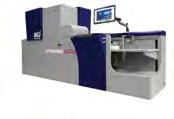
MGI JETVARNISH 3D ONE
Powerful, yet compact, this full, in-house production and prototyping print embellishment system means no screens, dies or plates.

ACCURIOWIDE
A hybrid UV LED wide format printer that produces a range of outdoor and indoor print job applications.
(Continued from page 16)
Budington: The idea was the mindset that we had to change is really to understand that everything we make, every project that we print, every website that we build, every new brand we reach to the world, there’s a business function behind it. So we can’t wait for a customer to call with a request. They have a message and we have a way to deliver that message. Our entire industry is set up to respond to that phone call as opposed to invent the need. For us, the idea of recasting ourselves as creative was to say that our full investment was going to be in understanding the value of the client, not being solely wed to the idea that can only be print. It’s not equipment. It’s not variable data. It’s understanding how to talk to a very complex audience of customers.
Moe: Nine years ago or so we decided that if we were going to survive, we had to take the name print out of our company. So people asked what were we going to do when the name of our company is Daily Printing? I didn’t want to change the name. If we did, we were going to cause some of our very good clients to question whether or not we still wanted to do business with them. And we had to have those conversations internally. We had to have real conversations about having a sustainable business model. So we made the journey to change and got through it together.
Danner: The printing industry is full of the most amazing hardworking focused people. They are introverted and very much rule followers. They tend to be patient people. But that’s the antithesis to growing a company. You need risk takers. You don’t want rule followers; you want rule breakers. You want extroverts more than you want introverts. In every position we hire, we also weigh the balance of “Do we want somebody with lots of experience? Or do we want somebody who we can develop and train?” It takes a lot of conversations with our older employees. They need to know that younger people are different.
“The biggest problem that printers have in front of them is that we are waiting for someone else to explain our relevance.”
“The biggest problem that printers have in front of them is that we are waiting for someone else to explain our relevance.”
— Jon Budington, President & CEO, More Vang
— Jon Budington, President & CEO, More Vang
They need mentoring. They need guidelines. They need to be taught a lot of things. But if you teach them, and they can wrap their arms around things the right way, they’ll bring you new ideas and new ways of doing things.
I think the other thing that we need to keep in mind as owners is that we need to continue to sell to our staff. It is my job to make sure I have people who want to come in and do a good job for me every day. I have to give them a reason. I have to reinforce that I appreciate them just like I do my customers.
Moe: I think there’s a fear to bring in younger people and get them trained. But you have to make an investment in them. And sometimes, just when you think you are going to get a return on your investment, they go someplace else. Those things are going to happen, so we cannot be afraid to bring in new people and develop them. I think one of the ways we can differentiate ourselves is by the people we surround ourselves with.
Budington: I am incredibly optimistic about the generations coming behind us. I cannot believe the talent that we have of people in their 20s and 30s— their creativity, their curiosity, their ability to learn new things quickly. I love that they have great ideas and ask great questions. I just want to stay out of their way.
“We need to keep in mind as owners that we need to continue to sell to our staff. It is my job to make sure I have people who want to come in and do a good job for me every day.”
“We need to keep in mind as owners that we need to continue to sell to our staff. It is my job to make sure I have people who want to come in and do a good job for me every day.”
— Gina Danner, CEO, NextPage
— Gina Danner, CEO, NextPage















Cougar® is noted as the premium paper of choice for conveying emotion and creating memorable experiences. With three luxurious finishes, two colors, matching envelopes, an extended digital offering and a vast array of sizes and weights, Cougar is a powerful way to bring your project to life.



















Request the latest Cougar printed sample at info.domtar.com/retail




By Jennifer Morrell
Several months ago, Think Patented gathered a group of employees together in its Dayton, Ohio, offices and had an honest discussion about the state of work today. The attendees were a multigenerational snapshot of its employee base, from younger workers to veterans, office staff to plant personnel, and everything in between. When the conversation shifted to opportunities for advancement within the state-of-the-art print company, the younger employees were more vocal about what happens when they hit the proverbial glass ceiling.
Kenneth O. McNerney, Think Patented’s CEO and Managing Partner, says the scenario is one all print companies face today. What happens when a younger employee gets to the point where there is no chance for advancement because of a staffer who has been there for say, 20 years? How do you promote that person who, in some instances, may be more driven and talented than the one who is there?
“You don’t want to find good people and then lose them because there is no place for them to go,” McNerney says. “Today’s younger employees are not interested in climbing the corporate ladder like the baby boomers were. They want to advance on their time. And they do not care who is in front of them.”
In today’s print landscape, where the search for the next generation of workers is at the top of every to-do list, understanding your employees’ wants and needs is more critical than ever before. The takeaway: If they do not get what they want from you, they will get it someplace else.
The numbers seem to bear that thought out. For example, according to the World Economic Forum’s 2019 “The Future of Jobs” report, 44% of workers say that changing work environments and flexible working arrangements is one of the biggest factors in their job search. Thanks to a slate of new technologies, today’s workplace is being transformed by remote working options, co-working spaces and teleconferencing.
Organizations are likely to have an ever-smaller pool of core full-time employees for fixed functions, backed up by colleagues in other places, and external consultants and contractors for specific projects.
As the report implicitly states, the technological revolution is not a race between humans and machines, but rather an opportunity for work to truly become a channel through which people recognize their full potential. “The single biggest
“The new workforce is motivated by their quality of work life, the relevancy to their interests and personal priorities and, ultimately, the ability to move a mission forward they truly believe in.”
— Nicholas Webb, Partner, LeaderLogic
difference in the new workforce is employee motivation,” says Nicholas J. Webb, author of the best-selling book, “The Innovation Mandate.” “The new workforce is motivated by their quality of work life, the relevancy to their interests and personal priorities and, ultimately, the ability to move a mission forward they truly believe in.”
In fact, Webb goes as far as to say that there may not even be such a thing as a traditional employee anymore, but instead a range of personas that companies must learn to understand. “The old days of hierarchy management has transitioned to collaborative and servitude,” says Webb, also a partner at management consulting firm LeaderLogic. “Talented employees have many options, and they only choose the one where they feel they have a voice and can make an impact.”
It is a point that companies like Think Patented have truly noted. The printer recently conducted a research report on how to retain millennials in the workplace, hoping to get a feel for what type of personas it was up against in today’s employee pool. The results opened eyes. Among some of the statistics it found were that 60% of millennials are currently looking for a new job, while 20% change jobs every year (Gallup). The one McNerney found most interesting was that 70% of employees do not believe their employers offer any professional growth opportunities (Cornerstone).
“You cannot order your employees around without giving any room for autonomy or feedback. They want to be respected and to have a chance to share their ideas.”
— Robert Glazer, CEO, Acceleration Partners
“ It changes your whole approach to managing people and expectations,” he says. “Employees used to want long-term stability, benefits and pensions. Today they want frequent pay increases, flex time, professional development opportunities, time off as a reward and appreciation.”
In his latest book, “Elevate: Push Beyond Your Limits and Unlock Success in Yourself and Others,” best-selling author Robert Glazer discussed a
concept called “capacity building,” which speaks to why today’s businesses must invest in their employees holistically. On a personal and professional level, you must give them the tools and motivation they need.
“When an employee improves in one area, it will elevate their game in others,” says Glazer, who also is CEO of Acceleration Partners. “An important thing to know is that command and control leadership doesn’t work in today’s environment. You cannot order your employees around without giving any room for autonomy or feedback. They want to be respected and to have a chance to share their ideas.”
Glazer says it is important for managers to create an environment where employees feel psychologically safe and empowered to make decisions that adhere to company values and advance the business. If your culture is healthy and you are hiring the right people, you do not need to control their every decision and action.
Troy Hall takes the concept to an even higher place, saying that managing people is out and leadership is in. “You need to motivate, influence and enable others to achieve success,” says Hall,

10
A
1 3 2
CREATE RADICAL CANDOR CULTURE —
From Kim Scott’s book of the same name, your team should be built on respect, trust and motivation. (Glazer)
UNDERSTAND FIT —
There is no one-culture-fits-all mold. Allow everyone to know what the company’s expectations are. (Glazer)
TREAT PEOPLE WELL —
Don’t take your employees’ loyalty and engagement for granted. Make them feel valued and respected and they will give their all. (Glazer)
Ph.D., a talent retention thought leader and Chief Strategy Officer for South Carolina Federal Credit Union. “With this mindset, leaders understand they have three fundamental activities that contribute to success: Effective leaders stimulate people into action; they mold the thinking of those they influence; and they provide resources and remove barriers.”
More than anything, employees want to feel like they belong and are part of something special. They want to feel valued for their individual and collective contributions toward common goals. “An organization’s leader can drive effectiveness with performance when he builds cohesive teams and it takes understanding the current workforce,” Hall says. “These characteristics transcend a generational label and can be applied, in concept, across all workers. Once they feel connected, they turn to find value in what they do.”
The thinking falls in line for what McNerney discovered in that Think Patented company meeting. If you can tie the jobs into employee goals, and focus on issues like training, advancement and incentives, you can build a culture of advancement and opportunity. “You want to create a leadership development program
BE VIGILANT IN SUCCESS —
The best leaders keep their teams motivated and alert even when things are going well. (Glazer)
BE CLEAR AND CONSISTENT —
Clearly and consistently communicate your company’s core values. If you don’t, they won’t. (Glazer)
STOP DIRECTING, START INSPIRING —
Your employees want to be involved in a mission that matters and connects their uniqueness to their work. Reimagine and re-articulate goals and objectives in a way that inspires. (Webb)
“An organization’s leader can drive effectiveness with performance when he builds cohesive teams, and it takes understanding the current workforce.”
— Troy Hall, Chief Strategy Officer, South Carolina Federal Credit Union
that gives everyone equal opportunity to learn and grow.”
As Webb says, some of the world’s best organizations are leveraging game mechanics and social engagement to drive higher levels of employee satisfaction and productivity. They are creating collaborative communities, internal digital innovation networks and strategic challenges that help improve employee productivity and happiness.
What does your plan look like?

RECOGNIZE THEIR WORK —
Give your employees a safe place to authentically rate you on how you inspire and lead them as their manager. (Webb) 4 5 6 7 8 9 10
By acknowledging great work, you are being authentic. When done properly, recognition can be transformative to organizational culture and quality of work life. (Webb)
PROVIDE WELLNESS CHECKS —
Schedule monthly wellness checks with each employee to see how you can serve them better and improve their quality of life. (Webb)
ENGAGE, ENGAGE, ENGAGE —
Use internal enterprise social networks and thoughtful branding to recognize each employee’s contribution to the team. (Webb)
CHECK YOURSELF —













































